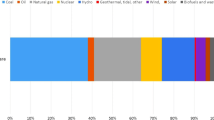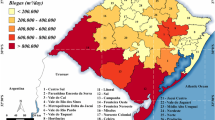Abstract
Biomass is a renewable energy resource derived from all organic materials produced by both human and natural activities. Total biomass is amounted to be 58,010 Gg yr−1 from agricultural sector during 2013 in Korea: livestock manure, crop residues, and agro-industrial wastes. Potential methane production from agricultural biomass was calculated based on IPCC guidelines using manipulated equations. The main parameters were emission factor, total waste amount, and physico-chemical properties of each waste to estimate methane production. Calculated total potential methane production from the different categories for livestock, crop residues, and agro-industrial wastes was 502 Gg yr−1 in Korea. Poultry waste generated the highest methane potential with 227 Gg yr−1 followed by 80 Gg yr−1 from cattle waste. For crop residues and agro-industrial wastes, estimated methane production was 1 and 126 Gg yr−1, respectively. Results of this study show that livestock manure gave the highest methane emission in the agricultural sector. With this, more effective management of livestock wastes is necessary to develop and maximize technology on harnessing methane as alternative energy.

Similar content being viewed by others
References
Abu-Ashour J, Abu Qdais H, Al-Widyan M (2010) Estimation of animal and olive solid wastes in Jordan and their potential as a supplementary energy source: an overview. Renew Sustain Energy Rev. doi:10.1016/j.rser.2010.03.001
Amon T, Amon B, Kryvoruchko V, Machmüller A, Hopfner-Sixt K, Bodiroza V, Hrbek R, Friedel J, Pötsch E, Wagentristl H, Schreniner M, Zollitsch W (2007) Methane production through anaerobic digestion of various energy crops grown in sustainable crop rotations. Bioresour Technol. doi:10.1016/j.biortech.2006.07.007
Bauen A, Woods J, Hailes R (2004) Biopowerswitch!—a biomass blueprint to meet 15% of OECD electricity demand by 2020. WWF Climate change program
Deublin D, Steinhauser A (2011) Biogas from waste and renewable resources, 2nd edn. Wiley, Weinheim
Frear C, Zhao B, Fu G, Richardson M, Chen S (2005) Biomass inventory and bioenergy assessment. Washington State Department of Ecology. 05-07-047
Gunaseelan VN (2004) Biochemical methane potential of fruits and vegetable solid waste feedstocks. Biomass Bioenergy. doi:10.1016/j.biombioe.2003.08.006
Hong S (2004) Evaluation of agricultural biomass resources for renewable energy—biomass from orchards and non-paddy fields. J Korean Soc Agric Eng. doi:10.5389/KSAE.2004.46.3.085
Hong J, Moon G, Lee J, Cho J (1989) Biomass resources survey and energy evaluation. Korean Institute of Energy Research, Daejeon
IPCC (2006) IPCC guidelines for national greenhouse gas inventories. Intergovernmental Panels on Climate Change, London
Janssen LHJM, Olivier JGJ, van Amstel AR (1999) Comparison of CH4 emission inventory data and emission estimates from atmospheric transport models and concentration measurements. Environ Sci Policy. doi:10.1016/S1462-9011(99)00020-9
JAYCOR (1990) Regional assessment of non-forestry-related biomass resources, summary volume Report No. 684-0035a/90. Southeastern Regional Biomass Energy Program, Muscle Shoals
Kaparaju P, Luostarinen S, Kalmari E, Kalmari J, Rintala J (2002) Co-digestion of energy crops and industrial confectionery by-products with cow manure: batch-scale and farm-scale evaluation. Water Sci Technol 45(10):275–280
Khanal SK (2008) Anaerobic biotechnology for bioenergy production: principles and applications. Wiley-Blackwell, Ames
Laifeld J, Fuhrer J (2005) Greenhouse gas emissions from Swiss agriculture since 1990: implications for environmental policies to mitigate global warming. Environ Sci. doi:10.1016/j.envsci.2005.04.001
Lee J, Kim G (2008) The potential of soil carbon sequestration by land use. In: Study on carbon sink agricultural sector regarding UNFCCC, RDA Final Report
MIFAFF (2009) Annual statistics in food, agriculture, fisheries and forestry in 2008. Korean Ministry for Food, Agriculture, Fisheries and Forestry
MIFAFF (2010) Annual statistics in food, agriculture, fisheries and forestry in 2009. Korean Ministry for Food, Agriculture, Fisheries and Forestry, Gwacheon
MIFAFF (2014) Annual statistics in food, agriculture, fisheries and forestry in 2013. Korean Ministry for Food, Agriculture, Fisheries and Forestry, Gwacheon
MOE (2008) Annual report of Korean environment in 2007. Korean Ministry of Environment, Sejong
Monni S, Syri S, Savolainen I (2004) Uncertainties in the Finnish greenhouse gas emission inventory. Environ Sci Policy. doi:10.1016/j.envsci.2004.01.002
Moss AR, Jounay JP, Newbold J (2000) Methane production by ruminants: its contribution to global warming. Ann Zootech 49:231–253
NIAS (2009) The Study to re-establish the amount and major compositions of manure from livestock. National Institute of Animal Science, Rural Development Administration, Jeonju
NRC (1983) National Research Council Committee on animal nutrition, underutilized resources as animal feedstuffs. The National Academy of Science, Washington
NREL (2005) A geographic perspective on the current biomass resource availability in the United States, A. Milbrandt
Olivier JGJ, Bouwman AF, Berdowski JJM, Veldt C, Bloos JPJ, Visschedijk AJH, van der Maas CWM, Zandveld PYJ (1999) Sectoral emission inventories of greenhouse gases for 1990 on a per country basis as well as on 1x1. Environ Sci Policy. doi:10.1016/S1462-9011(99)00027-1
Overend RP (2002) Biomass-fired power generation in North America. In: Kyoto University international symposium on post-petrofuels in the 21st century: prospects in the future of biomass energy, Montreal, 3–4 Sept
RDA (2009) International workshop of development bioenergy and conserving the natural ecosystem in APEC member economies. Rural Administration Development, Jeonju
Shin J, Han S, Eom K, Sung S, Park S, Kim H (2008) Predicting methane production potential of anaerobic co-digestion of swine manure and food waste. Environ Eng Res. doi:10.4491/eer.2008.13.2.093
Wang J, Cardenas LM, Misselbrook TH, Gilhespy S (2011) Development and application of a detailed inventory framework for estimating nitrous oxide and methane emission from agriculture. Atmos Environ. doi:10.1016/j.atmosenv.2010.12.014
Woods SM, Layzell DB (2003) A Canadian biomass inventory: feedstock for a bio-based economy. BIOCAP-Industry Canada Contract # 5006125. Final Report
Yang SS, Liu CM, Lai CM, Liu YL (2003) Estimation of methane and nitrous oxide from paddy fields and uplands during 1990-2000 in Taiwan. Chemosphere. doi:10.1016/S0045-6535(03)00029-8
Yoon Y, Kim H, Yoo J, Kim S, Hong S, Kim C (2011) The performance of anaerobic co-digester of wine slurry and food waste. Korean J Soil Sci Fert 44:104–111
Youn J, Shin H (2005) Comparative performance between temperature-phased and conventional mesophilic two-phased processes in terms of anaerobically produced bioenergy from food waste. Waste Manag Res 23:32–38
Acknowledgments
This study was supported by “Research Program for Agricultural Science & Technology Development (Project No. PJ010920),” National Institute of Agricultural Science, Rural Development Administration, Republic of Korea.
Author information
Authors and Affiliations
Corresponding author
Rights and permissions
About this article
Cite this article
Shin, J., Hong, S.G., Kim, SC. et al. Estimation of potential methane production through the mass balance equations from agricultural biomass in Korea. Appl Biol Chem 59, 765–773 (2016). https://doi.org/10.1007/s13765-016-0224-1
Received:
Accepted:
Published:
Issue Date:
DOI: https://doi.org/10.1007/s13765-016-0224-1




